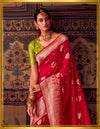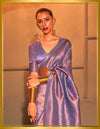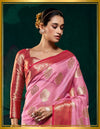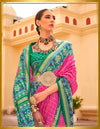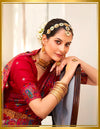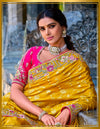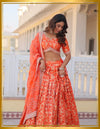11 Banarasi Saree Motifs and Their Beautiful Meanings
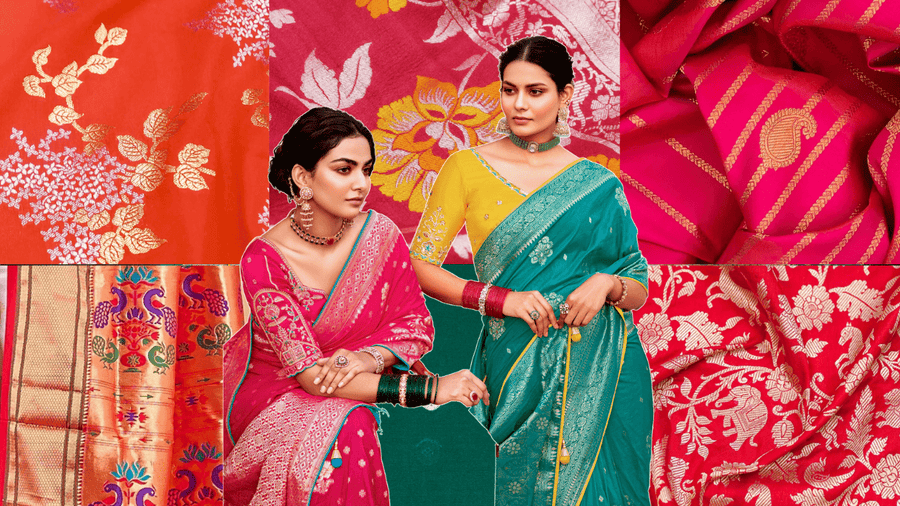
A Banarasi saree does not just decorate. It remembers.
Each motif is not a mere design. It is an imprint — of royalty, of old rituals, of borrowed ideas turned Indian. These motifs are the breath of the saree. They come from Persia, Bengal, temples, forests, Mughal tents, Buddhist carvings, and even bamboo mats. And each has its own logic, purpose, and personality.
This is an extensive walk through those motifs. Not just names. But why they matter, what they mean, and where they come from? With it, a few real visuals — how it might look, feel, drape, and live on a person.
1. Mango Motif

The mango motif is known by several names across regions, including Ambi (Punjabi), Kalka (Persian), Mangaai (Tamil), Kairi (Gujarati), and Boteh (original Persian). This curved teardrop or kidney-like shape is one of the oldest and most iconic motifs in Indian textile history.
In Indian mythology, the mango fruit holds deep symbolism. Even in legends, Lord Ganesha and Lord Muruga are said to have fought to eat the divine mango, underlining its sacred status. Across dynasties, the motif maintained its place. Emperor Jahangir and King Akbar famously patronised mango imagery in their palaces, inlay work, and attire. Eventually, it became a widely woven element in Banarasi sarees.
The mango stands for prosperity, abundance, and divine blessing. In Banarasi weaving, it has taken many forms — from small butis (called ambiya butis) arranged across the body to large paisley clusters woven into pallus or borders. Some carry vines, birds, or floral detailing inside the mango form.
One distinctive form seen in Banaras is the Kacha Mango Motif, typically woven using the Kadwa technique — where each mango is hand-woven separately, ensuring a rich, raised texture and longevity.
Another interpretation comes through Tanchoi weaving — a fine technique that uses a single or double warp with two to five different coloured weft threads. This creates detailed, softly embossed paisley shapes with a satin-like sheen.
Some sarees combine the mango motif with Meenakari work in the pallu and borders, where colourful silk threads add softness and richness to the zari-heavy design. Together, they create a look that is intricate but graceful, festive yet rooted.
This motif came to Banaras centuries ago and continues to evolve. It may be old, but it never went out of shape.
2. Bel and Bel Buti Motif

Bel means vine. But it is not just any vine — it is one that creeps with grace and blooms with symbolism.
Its roots are Persian. Thin, curving tendrils, often dotted with flowers, buds, or tiny fruits. The Mughals adopted it and transformed it, incorporating it into courtly carpets, murals, and clothing. From there, it entered Banarasi weaving and stayed.
The Bel Buti is a fusion of the flowing vine and the floral buti. The buti, also a Persian word, simply means a small motif or dot. Together, the bel butta becomes a vine decorated with floral dots — some large and central, others small and repeated in rows.
But the buta is not random. Its form may echo a jasmine bud, a marigold bloom, or a stylised rose. These hold value in Indian culture — associated with joy, purity, or strength. Bel buti sarees are worn during housewarming, annaprashan, pujas, and festivals.
Some weavers today draw from Western architectural details to stylise the vines. Others use Meenakari threads in multiple hues to fill in the butis, adding colour depth without overloading the weave. The zari creepers curve around the body like garlands, and the borders often carry more defined creeper frames. The pallus usually hold the largest bel buttas, shining with gold artistry.
This motif has endured because it carries softness. It celebrates growth. A bel buti saree does not stand still — it feels like it is climbing upward, quietly.
3. Ashrafi Buti

Ashrafi butis are small round motifs shaped like gold coins — directly referring to wealth, blessings, and auspiciousness.
During Mughal times, coins were not just currency but ceremonial offerings. This made the Ashrafi motif a token of prosperity. In Banarasi weaving, it became a favoured pattern for newborn ceremonies, Diwali celebrations, and wedding gifting.
The layout is usually a neat scatter across navy, green, or crimson backgrounds. Sarees with this motif are often paired with Ganga-Jamuna borders (dual-toned zari work) and worn across generations.
4. Butidar Motif

Butidar patterns are like rhythm in weaving.
These are small motifs — dots, tiny paisleys, or geometric shapes spaced consistently across the saree body. The spacing itself is an art. Too much, and it feels empty. Too close, and it looks crowded. Skilled weavers judge this by eye.
Older butidar sarees were woven using gold and silver threads together — the classic Ganga-Jamuna technique. The results were rich but wearable, suited for religious rituals, family events, and even as daily wear among noblewomen.
Today, these sarees still carry that effortless grace. You do not wear them to show off. You wear them because they feel right.
5. Jangla Motif

Jangla means jungle — and it shows.
This design covers the entire saree with twisting vines, blooming flowers, and crawling creepers. It is not about subtlety. It is about abundance. The older jangla sarees were woven using real silver zari and sometimes took months to complete.
These are considered bridal-level heirloom pieces. The pallu usually features the wildest spread, almost like a canopy of gold.
The base silk is often darker maroon, emerald, deep indigo — so the metallic vines catch light like wet branches. You do not need jewelry. The saree wears it for you.
6. Shikargah Motif

Shikargah means “the hunting ground.”
The motif tells a story: royal riders on horses, deer in mid-leap, tigers chasing prey, parrots flying past elephants. It is narrative, not decorative.
These motifs were common in Mughal art and were later adapted into Banarasi weaving for wealthy patrons. Weaving this is like painting with thread. It takes precision and days of focused work.
Shikargah sarees are rare now. But if you find one, it carries a full forest with it.
7. Floral Jaal

In Indian life, flowers are everywhere. From garlands to altar trays, from weddings to funerals, no ritual breathes without them. Their meanings are deeply tied to emotion, ceremony, and change.
That is why Floral Jaal remains one of the most beloved Banarasi designs.
A jaal is a net. A mesh. In Banarasi terms, it means an all-over spread of flowers and vines. Not isolated. Not scattered. But linked. United.
The floral jaal is thought to have first appeared when Gujarati silk weavers settled in Varanasi around the early 1600s. But it blossomed fully during the Mughal rule. Their fondness for symmetrical gardens, their obsession with blooms — it all got stitched into Banarasi silks.
These motifs include roses, lotuses, jasmine, or entirely imagined blossoms. Each flower may carry meanings: lotus for purity, rose for love, jasmine for grace. And when they repeat across the saree — vine to vine, root to bud — they bring structure to emotion.
The intricacy of these designs shows the weaver’s skill. To place every flower at the right distance, to make vines curve just enough, to balance blank space against zari-filled details — that takes memory and instinct.
Some of the most exquisite jaal sarees are woven in deep hues like wine or maroon, with gold zari forming the floral web. Borders carry creepers. The pallus explodes into bloom. With tilfi and meenakari, the jaal glows in red, green, or dull turquoise.
The result? A saree that feels like a garden under moonlight. Regal, but never loud. Ancient, but never old.
8. Tota Maina

The parrot and the myna — chirpy, cheeky, almost teasing — show up in Banarasi motifs as lovebirds. Sometimes they face each other, sometimes they perch in opposite corners.
They are woven into vines or hidden among mango motifs. The story here is lighthearted: young love, playful quarrels, wedding songs. These sarees are often picked for haldi functions, mehendi days, and casual celebrations.
9. Fish, Shell, and Bird Motifs

Especially seen in sarees sold in the Bengal region.
Fish stands for fertility and abundance. Conch shells represent sacred beginnings. Small birds often symbolise joy, messengers, or even souls.
These motifs are often tiny, repeating, and scattered across the body. They rarely dominate — but they never go unnoticed.
10. Kalga and Kangi
Kalga is a curved crown-like sprig. Kangi looks like the teeth of a comb.
Both entered through Persian textile influences and found a place in pallu designs and border frameworks. Their sharpness provides contrast to the floral softness. Together, they bring symmetry and poise.
11. Tilfi and Tanchoi (Weaving Styles Linked to Motifs)
Tilfi is a weaving method where extra threads of colour are added to give a raised, shaded, almost glowing texture. It is used in paisleys, birds, lotuses — wherever emotion needs more colour.

Tanchoi, on the other hand, uses no zari. It layers multiple coloured threads to build motif-only sarees. A Tanchoi mango buti looks like it is drawn with thread — flat, satin-finished, yet full of detail.
Both are slow. Both are worth it.
Additional Motifs You May See in Banarasi Sarees
Neem Leaf and Tulsi Borders
In many temple-wear sarees, borders inspired by neem leaves or tulsi sprigs are common. The shape is simple, pointed, narrow, and repeated in line. These represent purity and spiritual protection.
Mahapadma or Lotus Rosette
A stylised lotus in full bloom, placed often at the centre of the pallu or inside a chakra formation. It is seen as a sign of enlightenment, awakening, and beauty born from struggle.
Temple Peaks (Gopuram Patterns)
Borders resembling the upward steps of temple spires. Common in South-Banarasi hybrid styles. These add architectural weight to the saree and pair well with plain bodies.
Pan Leaf Motif
A stylised betel leaf, sometimes single, sometimes in clusters. Often woven in dull gold on pastel silks. It is associated with freshness, devotion, and welcome.
When You Wear One

Ask who it was made for.
A vine-covered saree? Probably a bride. A butidar saree? A woman stepping into a new home. A fish and shell motif? A mother blessing her daughter-in-law.
These are not just patterns. They are memories you can touch.
When you wear Banarasi, you are not just draping fabric. You are wearing the work of a hundred hands and the memory of a thousand hearts.
 New Arrivals
New Arrivals
 Saree Weaves
Saree Weaves
 Banarasi Sarees
Banarasi Sarees
 Kanjivaram Sarees
Kanjivaram Sarees
 Paithani Sarees
Paithani Sarees
 Patola Sarees
Patola Sarees
 Organza Sarees
Organza Sarees
 Chikankari Sarees
Chikankari Sarees
 Kashmiri Jamawar Sarees
Kashmiri Jamawar Sarees
 Dola Silk Sarees
Dola Silk Sarees
 Dharmavaram Silk Sarees
Dharmavaram Silk Sarees
 Saree Fabric
Saree Fabric
 Silk Sarees
Silk Sarees
 Soft Silk Sarees
Soft Silk Sarees
 Linen Sarees
Linen Sarees
 Satin Sarees
Satin Sarees
 Digital Printed Sarees
Digital Printed Sarees
 Tissue Silk Sarees
Tissue Silk Sarees
 Occasion
Occasion
 Festive Wear Sarees
Festive Wear Sarees
 Office Wear Sarees
Office Wear Sarees
 Party Wear Sarees
Party Wear Sarees
 Luxe Collection
Luxe Collection
 Wedding Collection
Wedding Collection
 Engagement Sarees
Engagement Sarees
 Haldi Sarees
Haldi Sarees
 Sangeet Sarees
Sangeet Sarees
 Wedding Banarasi Sarees
Wedding Banarasi Sarees
 Wedding Kanjivaram Sarees
Wedding Kanjivaram Sarees
 Wedding Organza Sarees
Wedding Organza Sarees
 Wedding Patola Sarees
Wedding Patola Sarees
 Sarees By Color
Sarees By Color
 Price Range
Price Range
 Designer Silk Sarees
Designer Silk Sarees
 Track Your Order
Track Your Order
